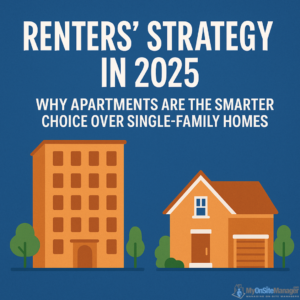As rental costs continue to rise across the U.S., renters are facing tough choices about where to live, what to rent, and how to stretch their budgets without sacrificing comfort. While single-family homes may offer more space and privacy, the numbers don’t lie—apartments are now emerging as the more cost-effective option in 2025. If you’re navigating the rental market, you might want to shift your sights to apartments—and here’s why.
A Widening Price Gap: Single-Family Homes vs. Apartments
Over the last few years, rental prices have skyrocketed—but not evenly across all housing types. According to a recent analysis, single-family home rents have increased by a staggering 41% since before the pandemic. Meanwhile, apartment rents have climbed only 26% in the same period.
As of January 2025:
-
Single-family home average rent: $2,179/month
-
Apartment average rent: $1,820/month
That’s a difference of over $350 per month, which adds up to more than $4,000 annually—a substantial savings for most renters.
Why Are Apartments More Affordable Right Now?
There’s a simple reason behind the price gap: supply and demand.
Over the past several years, developers have ramped up construction of apartment buildings, especially in urban areas. This construction boom has introduced a significant number of new units to the market, creating more competition and keeping apartment prices relatively stable.
In contrast, the supply of single-family homes available for rent remains limited. With fewer options available and growing demand from renters seeking more space, prices for these homes have been pushed upward significantly.
Changing Life Stages, Changing Needs
Many renters in 2025 are older millennials, now around 38 years old, who are navigating new life stages—marriage, parenting, remote work, and saving for a home. While a single-family home may appear to fit those needs better, financial realities are getting in the way.
With high mortgage rates and rising home prices, many would-be buyers are stuck renting longer than expected. This keeps competition high in the single-family rental market and pushes prices further out of reach.
Apartment Living: More Than Just a Budget Option
Aside from lower rent, apartments offer a variety of practical benefits:
-
Less maintenance – Landlords typically cover repairs and upkeep.
-
Modern amenities – Many newer apartment complexes feature gyms, pools, co-working lounges, and community events.
-
Urban convenience – Apartments are often closer to public transportation, shops, and workplaces, cutting down on commuting costs and time.
For renters who want affordability without giving up convenience or comfort, apartments provide a well-rounded solution.
Planning for the Future: Renting Today, Owning Tomorrow
If homeownership is your long-term goal, choosing a more affordable apartment today could help you save money faster. Here’s how to prepare:
-
Build your credit score – Pay bills on time and keep credit card balances low.
-
Reduce debt – Lower your debt-to-income ratio to increase your chances of mortgage approval.
-
Increase your income – Look for ways to boost earnings, including side gigs or career advancement.
By living below your means in an apartment now, you can position yourself for a stronger financial future and a more seamless transition into homeownership when the time is right.
Final Thoughts
In today’s evolving housing landscape, flexibility and strategy are key. While single-family homes remain desirable, they’re not always practical—especially in a market where affordability is a growing concern.
If you’re looking for a better rental deal in 2025, targeting apartments may be your best move. They offer cost savings, lower maintenance responsibilities, and access to modern amenities—all while keeping your homeownership dreams alive.
Source: Renters ought to target this kind of home for a better deal – New York Post

